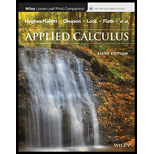
APPLIED CALCULUS-PRINT COMPANION (LL)
6th Edition
ISBN: 9781119275565
Author: Hughes-Hallett
Publisher: WILEY
expand_more
expand_more
format_list_bulleted
Concept explainers
Question
Chapter 10.3, Problem 9P
To determine
In long run, how much of this toxin accumulates in the person’s body? Give the quantities right after and right before lunch.
Expert Solution & Answer
Want to see the full answer?
Check out a sample textbook solution
Students have asked these similar questions
2. [-/4 Points]
DETAILS
MY NOTES
SESSCALCET2 7.3.002.
Let S be the solid obtained by rotating the region shown in the figure about the y-axis. (Assume a = 6 and b = 2.)
ASK YOUR TEACHER
0
y = a sin(bx²)
Sketch a typical approximating shell.
y
6
4
2
x
π/b
y
2
1
x
0.5
1.0
1.5
0.2
0.4
0.6
0.8
1.0
-2
-1
-4
The graph of f', the derivative of f, is shown in the graph below. If f(-9) = -5, what is the value of f(-1)?
y
87 19
6
LO
5
4
3
1
Graph of f'
x
-10 -9 -8 -7 -6 -5 -4 -3 -2 -1
1
2
3
4 5
6
7 8 9 10
-1
-2
-3
-4
-5
-6
-7
-8
564%
Let f(x)=−7e^xsinxf'(x)=
Chapter 10 Solutions
APPLIED CALCULUS-PRINT COMPANION (LL)
Ch. 10.1 - Prob. 1PCh. 10.1 - Prob. 2PCh. 10.1 - Prob. 3PCh. 10.1 - Prob. 4PCh. 10.1 - Prob. 5PCh. 10.1 - Prob. 6PCh. 10.1 - Prob. 7PCh. 10.1 - Prob. 8PCh. 10.1 - Prob. 9PCh. 10.1 - Prob. 10P
Ch. 10.1 - Prob. 11PCh. 10.1 - Prob. 12PCh. 10.1 - Prob. 13PCh. 10.1 - Prob. 14PCh. 10.1 - Prob. 15PCh. 10.1 - Prob. 16PCh. 10.1 - Prob. 17PCh. 10.1 - Prob. 18PCh. 10.1 - Prob. 19PCh. 10.1 - Prob. 20PCh. 10.1 - Prob. 21PCh. 10.1 - Prob. 22PCh. 10.1 - Prob. 23PCh. 10.1 - Prob. 24PCh. 10.1 - Prob. 25PCh. 10.1 - Prob. 26PCh. 10.1 - Prob. 27PCh. 10.1 - Prob. 28PCh. 10.1 - Prob. 29PCh. 10.1 - Prob. 30PCh. 10.2 - Prob. 1PCh. 10.2 - Prob. 2PCh. 10.2 - Prob. 3PCh. 10.2 - Prob. 4PCh. 10.2 - Prob. 5PCh. 10.2 - Prob. 6PCh. 10.2 - Prob. 7PCh. 10.2 - Prob. 8PCh. 10.2 - Prob. 9PCh. 10.2 - Prob. 10PCh. 10.2 - Prob. 11PCh. 10.2 - Prob. 12PCh. 10.2 - Prob. 13PCh. 10.2 - Prob. 14PCh. 10.2 - Prob. 15PCh. 10.2 - Prob. 16PCh. 10.2 - Prob. 17PCh. 10.2 - Prob. 18PCh. 10.2 - Prob. 19PCh. 10.2 - Prob. 20PCh. 10.3 - Prob. 1PCh. 10.3 - Prob. 2PCh. 10.3 - Prob. 3PCh. 10.3 - Prob. 4PCh. 10.3 - Prob. 5PCh. 10.3 - Prob. 6PCh. 10.3 - Prob. 7PCh. 10.3 - Prob. 8PCh. 10.3 - Prob. 9PCh. 10.3 - Prob. 10PCh. 10.3 - Prob. 11PCh. 10.3 - Prob. 12PCh. 10.3 - Prob. 13PCh. 10.3 - Prob. 14PCh. 10.3 - Prob. 15PCh. 10.3 - Prob. 16PCh. 10.3 - Prob. 17PCh. 10.3 - Prob. 18PCh. 10.3 - Prob. 19PCh. 10.3 - Prob. 20PCh. 10 - Prob. 1SYUCh. 10 - Prob. 2SYUCh. 10 - Prob. 3SYUCh. 10 - Prob. 4SYUCh. 10 - Prob. 5SYUCh. 10 - Prob. 6SYUCh. 10 - Prob. 7SYUCh. 10 - Prob. 8SYUCh. 10 - Prob. 9SYUCh. 10 - Prob. 10SYUCh. 10 - Prob. 11SYUCh. 10 - Prob. 12SYUCh. 10 - Prob. 13SYUCh. 10 - Prob. 14SYUCh. 10 - Prob. 15SYUCh. 10 - Prob. 16SYUCh. 10 - Prob. 17SYUCh. 10 - Prob. 18SYUCh. 10 - Prob. 19SYUCh. 10 - Prob. 20SYUCh. 10 - Prob. 21SYUCh. 10 - Prob. 22SYUCh. 10 - Prob. 23SYUCh. 10 - Prob. 24SYUCh. 10 - Prob. 25SYUCh. 10 - Prob. 26SYUCh. 10 - Prob. 27SYUCh. 10 - Prob. 28SYUCh. 10 - Prob. 29SYUCh. 10 - Prob. 30SYU
Knowledge Booster
Learn more about
Need a deep-dive on the concept behind this application? Look no further. Learn more about this topic, calculus and related others by exploring similar questions and additional content below.Similar questions
arrow_back_ios
SEE MORE QUESTIONS
arrow_forward_ios
Recommended textbooks for you

 Glencoe Algebra 1, Student Edition, 9780079039897...AlgebraISBN:9780079039897Author:CarterPublisher:McGraw Hill
Glencoe Algebra 1, Student Edition, 9780079039897...AlgebraISBN:9780079039897Author:CarterPublisher:McGraw Hill College Algebra (MindTap Course List)AlgebraISBN:9781305652231Author:R. David Gustafson, Jeff HughesPublisher:Cengage Learning
College Algebra (MindTap Course List)AlgebraISBN:9781305652231Author:R. David Gustafson, Jeff HughesPublisher:Cengage Learning
 Trigonometry (MindTap Course List)TrigonometryISBN:9781337278461Author:Ron LarsonPublisher:Cengage Learning
Trigonometry (MindTap Course List)TrigonometryISBN:9781337278461Author:Ron LarsonPublisher:Cengage Learning Algebra: Structure And Method, Book 1AlgebraISBN:9780395977224Author:Richard G. Brown, Mary P. Dolciani, Robert H. Sorgenfrey, William L. ColePublisher:McDougal Littell
Algebra: Structure And Method, Book 1AlgebraISBN:9780395977224Author:Richard G. Brown, Mary P. Dolciani, Robert H. Sorgenfrey, William L. ColePublisher:McDougal Littell


Glencoe Algebra 1, Student Edition, 9780079039897...
Algebra
ISBN:9780079039897
Author:Carter
Publisher:McGraw Hill

College Algebra (MindTap Course List)
Algebra
ISBN:9781305652231
Author:R. David Gustafson, Jeff Hughes
Publisher:Cengage Learning


Trigonometry (MindTap Course List)
Trigonometry
ISBN:9781337278461
Author:Ron Larson
Publisher:Cengage Learning

Algebra: Structure And Method, Book 1
Algebra
ISBN:9780395977224
Author:Richard G. Brown, Mary P. Dolciani, Robert H. Sorgenfrey, William L. Cole
Publisher:McDougal Littell
Statistics 4.1 Point Estimators; Author: Dr. Jack L. Jackson II;https://www.youtube.com/watch?v=2MrI0J8XCEE;License: Standard YouTube License, CC-BY
Statistics 101: Point Estimators; Author: Brandon Foltz;https://www.youtube.com/watch?v=4v41z3HwLaM;License: Standard YouTube License, CC-BY
Central limit theorem; Author: 365 Data Science;https://www.youtube.com/watch?v=b5xQmk9veZ4;License: Standard YouTube License, CC-BY
Point Estimate Definition & Example; Author: Prof. Essa;https://www.youtube.com/watch?v=OTVwtvQmSn0;License: Standard Youtube License
Point Estimation; Author: Vamsidhar Ambatipudi;https://www.youtube.com/watch?v=flqhlM2bZWc;License: Standard Youtube License